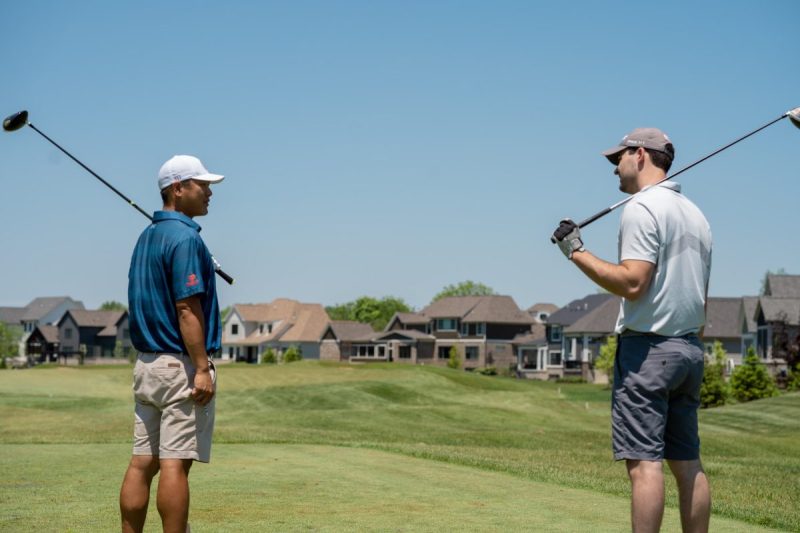Like any sport, the right equipment will get you the most out of your game. For golf, it might seem all you need is a set of clubs that feels like it was made for you. But there is another item you might want to use on the course. Whether you are new to golf or have been working on your putt for a while now, you should invest in a golf glove. While it may not perform a miracle for your handicap, wearing a golf glove could help you righten up your swing. If you want to grab one, what hand do you wear a golf glove on? Here’s what you need to know before you add this tool to your golf bag.
What hand you wear a golf glove on

While you may want to put the glove on your dominant hand, it’s the opposite. You always wear it on the opposite of your dominant hand. You don’t wear your watch on your dominant side to avoid getting it caught, scratched, or banged on something. Wearing a golf glove follows the rule of wearing a watch.
- If you are left-handed, wear the golf glove on your right hand.
- If you are right-handed, wear the golf glove on your left hand.
Why you wear your golf glove on your non-dominant hand
When it comes to swinging a club, your non-dominant hand leads and is the one closest to your body at the top of the grip on the golf club. This is the hand directing the club and needs precise handling, with the smallest movement counter to what you want throwing off your swing. It’s all about your grip on the club, and that is the hand in charge of it.
Reasons to wear a golf glove

Putting a golf glove on is a lot like wearing a batting glove in baseball and serves similar purposes.
- It helps to prevent blisters and calluses.
- It will soak up sweat to reduce friction.
- It gives golfers a better grip on the club.
- It can keep your hand warm in colder weather.
- Wearing a golf glove does increase performance.
Sports cause wear and tear on the body — that’s just how it is. A golf glove will save the lead hand from a bit of normal strain. There is no pain like having to grip a club and play with a blister that makes you want to drop to your knees. Not only will a glove protect the lead hand when you swing, but it will stop some of the sweat from dripping down your hand, which could cause the club to slip and your swing to not go how you planned.
Not only will a glove keep your hands warm if golfing in colder weather, but you might see an improvement in your score. A test was done to prove that using a golf glove does have a positive result when it comes using a driver, 7-iron, and a pitching wedge.
Not everyone wears a golf glove
Even some of the pros opt out of wearing a golf glove. It is up to each player to decide if they play better with or without it. Some players wear one on each hand, some take them off to putt, and some never wear them. When it’s raining out, you might see more golfers wearing two golf rain gloves. Since everything is wet and the grip is a bit of a toss-up at that point, anything to stabilize your swing is welcome.
Have the correct golf glove

You shouldn’t just wander into a sports store and ask for a golf glove if you have never purchased one. Picking out a glove for yourself is like finding the right outfit for an occasion — it might take a little time to find a match.
- Make sure you buy the correct hand glove.
- Look for ones made of soft cabretta leather.
- Know the difference between a thinner and thicker glove.
- Try it on before you buy it.
To make it more confusing, you can’t walk in and ask for a right-hand golf glove, or they will give you a glove for the right hand. If you are right-handed, you need a left-hand golf glove. After you get the correct hand, the material is the next thing to look for. A softer leather will mold to your hand like a dream, making it a second skin while being more durable and giving a better grip.
Whether you want a thicker or thinner glove is going to be personal preference. Thicker gloves will last longer, but thinner gloves allow for a better connection between you and your club. Whichever kind or style you buy, try it on first. While it will stretch a bit to fit you the more you use it, you don’t want your glove digging into your skin and costing you strokes out on the course.
Whether you think a golf glove will help your game will be up to you. Not everyone wants to wear one, but if you do, what hand you wear a golf glove on will make the difference in seeing an improvement in your game. If your score has stayed the same for a while, or you want to step on a course for the first time, think about picking up a golf glove — and understand which hand it goes on — to see if it puts a little pep in your swing.




